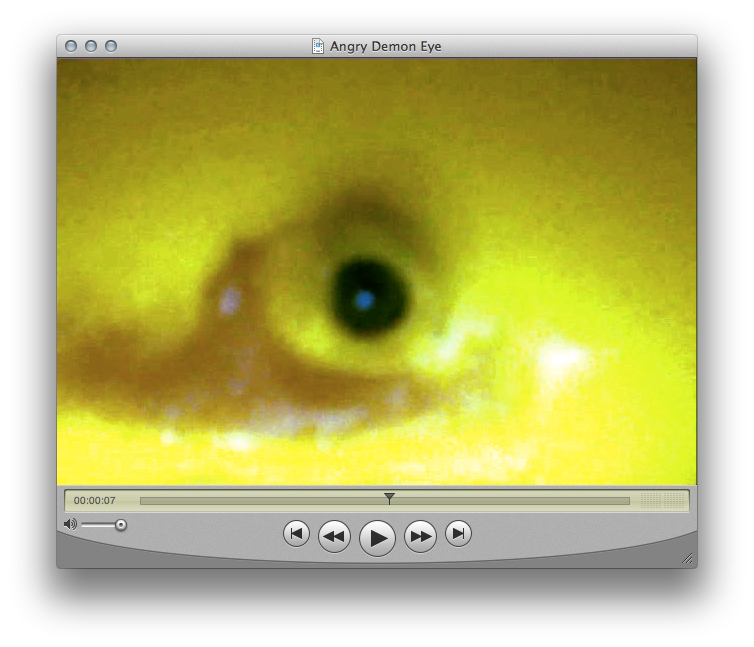In The ethereal glow and semi-transparency of cloaked demons explained, I introduced several principles of the science of light (or optics) that explain why you can see cloaked (or invisible) demons in the dark, and which also explain what causes their ghost-like appearance.
In this post, I will explain how diffraction, another scientific principle of optics, allows you to see a cloaked demon in the light.
Just like the science behind polarized light explains why cloaked demons appear illuminated in the dark, the science of diffracted light explains why an otherwise invisible demon can be seen in the daylight.
What made this demon visible—at least when a part of it was close to the hole—was the fact that the light reflecting off the eye passed over the edges of the hole, and were therefore spread out before entering the lens. When spread, they intersected with light rays passing straight ahead, which assumed the same wavelength upon collision. This increased the amount of light reflected from the eye, thereby making it visible, whereas a cloak words by decreasing reflected light.
Substitutes to lids with holes punctured through them
You can also make a fist while leaving a small hole in the middle and then point your camera through that to see hidden demons in the daylight; and, once, I was able to see a dragon-like demon out of my window as long as I looked through the slats in the blinds from a certain distance, but couldn't when I raised them.
On the night the Blanket Demon II video was made, while I slept, a demon had entered my room at my old apartment on Julian Street, which, as I stated above, is actually a nexus of hyperdimensional portal activity. Demons came and went all day and all night at that apartment, although not necessarily to see or otherwise interact with me. So, this was not unusual.
As you can see in the video, I'm trying to find it using my cellphone video camera and a makeshift light-tunnel aperture, specifically, the back cover of my cellphone and the lens hole. As I pan the room, the demon slid under my bedspread, which lay strewn on the floor from a mad dash for the light. As I get closer and closer to it, it suddenly springs up from the floor—with the bedspread still over its head—in order to scare me so it could make a safer getaway. You can see it move across the floor, knocking the lamp askew in the process:
In this post, I will explain how diffraction, another scientific principle of optics, allows you to see a cloaked demon in the light.
Just like the science behind polarized light explains why cloaked demons appear illuminated in the dark, the science of diffracted light explains why an otherwise invisible demon can be seen in the daylight.
One of the most easily observed facts about light is its tendency to travel in straight lines. Careful observation shows, however, that a light ray spreads slightly when passing the edges of an obstacle. This phenomenon is called diffraction.
[Source: McGraw-Hill Encyclopedia of Science & Technology, Volume 10, 8th Edition (1997)]Applying this principle, I was able to capture on video the curious eye of a one-and-a-half-foot tall imp demon, which moves faster than time, and which is virtually invisible in the daylight, as it peered through a hole drilled into a lid taped over the lens of my camera:
 |
| The eye of a demon peers through a hole in a lid fastened over the camera lens |
NOTE | This type of lens covering is called a light-tunnel aperture.In the video, you can barely see through the hole, but well enough to see a rapidly approaching shadow, which then instantly transforms into the fast-moving eye of a deadly, imp demon:
Substitutes to lids with holes punctured through them
You can also make a fist while leaving a small hole in the middle and then point your camera through that to see hidden demons in the daylight; and, once, I was able to see a dragon-like demon out of my window as long as I looked through the slats in the blinds from a certain distance, but couldn't when I raised them.
NOTE | The demon in the video is probably an assassin, looking for its kill, which it assumed was hiding in my apartment (a common occurrence), as my apartment was a nexus of hyperdimensional portal activity, and saw constant demon traffic [see VIDEO TIMELINE | Maskless Hobgoblin Demon Springs From Floor]. Combat of this kind was also common, even for me, as shown in ESPAÑOL | Demonios ardientes con el fuego.Other videos employing the light-tunnel aperture
On the night the Blanket Demon II video was made, while I slept, a demon had entered my room at my old apartment on Julian Street, which, as I stated above, is actually a nexus of hyperdimensional portal activity. Demons came and went all day and all night at that apartment, although not necessarily to see or otherwise interact with me. So, this was not unusual.
As you can see in the video, I'm trying to find it using my cellphone video camera and a makeshift light-tunnel aperture, specifically, the back cover of my cellphone and the lens hole. As I pan the room, the demon slid under my bedspread, which lay strewn on the floor from a mad dash for the light. As I get closer and closer to it, it suddenly springs up from the floor—with the bedspread still over its head—in order to scare me so it could make a safer getaway. You can see it move across the floor, knocking the lamp askew in the process: